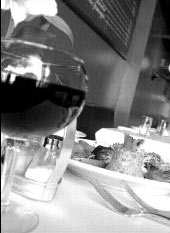BALD PAUL’S BUTTER for information, call 767-2777
Have you, like thousands of home cooks, ever thought, “Gee, I could sell my hot sauce/cupcakes/clam dip and get rich”? If so, consider the saga of Bald Paul before embarking on the rocky road of product development. Bald Paul (full name: Richard Paul Olafson) is not one of your midlife converts to the romance of food: He debuted in the business “bustin’ suds” at the Perkins Caf頡nd Steakhouse in White Center, going on to work his way up the restaurant ladder. At that point, he discovered snowboarding and fairly promptly broke both his ankles. This brush with medical bills and forced time off combined to light the entrepreneurial fire within. Bald Paul decided to create his own culinary niche: as a maker of gourmet compound butters.
Despite their unglamorous, even industrial-sounding name, compound butters are fundamental components of classic haute cuisine, used when chefs, amateur or professional, require classic flavor combinations in a fast, convenient package. In a French brasserie, snails are rarely served without their traditional companion, garlic/parsley butter, while a simple grilled filet steak may be catapulted to perfection with a pat of Roquefort butter. (Why, even dowdy old Marie Callender offers a tempting honey butter to gussy up her cornbread.)
Theoretically, such butters can easily be made at home. Just soften a stick of unsalted butter, mash in homegrown herbs and fresh-ground spices, and—hey, presto—you’ve got a lovely swirl of flavor to dot on homemade pasta or enrich the pan juices of those thin slices of pork from the friendly local butcher you found time to chat with during your daily rounds.
“Theoretically” is right. The whole point of flavored butters is to save time in the kitchen: Who’s going to take that extra 20 minutes to make some? Bald Paul, that’s who. Beginning today, he plans for three flavors of Bald Paul compound butter—pesto, garlic, and lemon-pepper—to be hitting the shop shelves and the pantries of fine restaurants. As the business establishes itself, there’ll be custom flavors for wholesale customers along with a rotating schedule of seasonal additions.
GETTING A FOOD-BASED small business off the ground requires a major effort. Creating from scratch a kitchen licensed to prepare food for public sale is prohibitively expensive. Like many newbies, Bald Paul sublets off-hours space at an established business—in this case, Essential Foods’ burrito kitchen. Paul whips up his butters in the wee hours after a full day’s work as a QFC produce man.
With a niche product like this, there’s no room for error. The product has to be both perfect from the start and affordable. Setting a price is tricky, as butter is subject to some pretty wild seasonal price fluctuations, but Paul hopes to keep the cost of a 6-ounce tub between $2.50 and $4.
In the quality department he feels no uncertainty. Ten years in the food biz taught him where to go for prime ingredients: Rosella’s Fruits and Produce (supplier to restaurants like Cassis and Caf頊uanita) for premium garlic and herbs; Aimonetto and Sons for an unsalted butter so exceptional that neither party will say a word about its provenance for fear of competitors horning in on a limited supply.
Wherever it comes from, Bald Paul’s butter is vastly superior to most available on the market; once the impeccably fresh herbs are blended in, Bald Paul compound butters are not just condiments but works of culinary art.
Finding the right packaging, in fact, has proved more difficult than perfecting what’s inside it. Paul believes he’ll find the ideal (gracefully designed, environmentally sound, affordable, 4-ounce-size) container in time. For now, he’s settled on a 6-ounce plastic tub that offers a sizable surface for his eye-catching logo. (Unwilling to turn out the usual homemade artwork, unable to pay for expensive professional design work, Bald Paul was able to prevail on commercial-art student friends Igwe Waters and Dareck Tobias to run up a cartoon version of his own shiny pate as centerpiece of the package.)
Butter suppliers Aimonetto and Sons can also help with a small food manufacturer’s biggest problem: distribution. Transport of perishables must meet exacting health department standards, requiring budget breakers like walk-in coolers and refrigerated trucks, while customers, especially buyers for large chains, generally won’t touch a product from an unknown maker.
Allied with Aimonetto and Sons, who have been supplying high-end dairy products and eggs to small shops and restaurants for 25 years, Paul is better positioned than most to break that barrier. His plan to hit the wholesale and retail markets simultaneously is bold but could pay off: A few regular restaurant customers will help meet the expenses of building a retail core, while “served in the finest restaurants” is a surefire sales pitch for the buyers at grocery stores.
With his first production run expected to hit the market this week, Paul’s days have been a whirlwind of paperwork and meetings. He’s not completely recovered from his ankle-busting snowboard accident, and there’s additional financial pressure due to family medical needs. But along with the hope of imminent profit, family is part of his long-term corporate goal: He wants his company to feel “like the family you always wanted to have dinner with, because everyone was so honest and respectful of each other.”
Not your typical business plan, but Bald Paul is not your typical businessman. And who knows: If everything works out, maybe one day Seattle will be known not just for coffee or software (or unemployment), but as the town where world-class compound butter was born.









